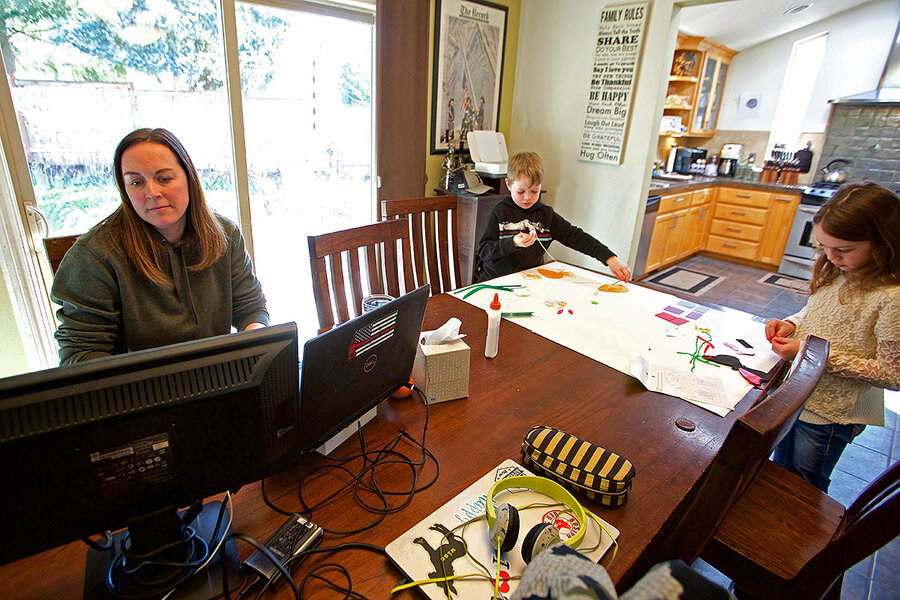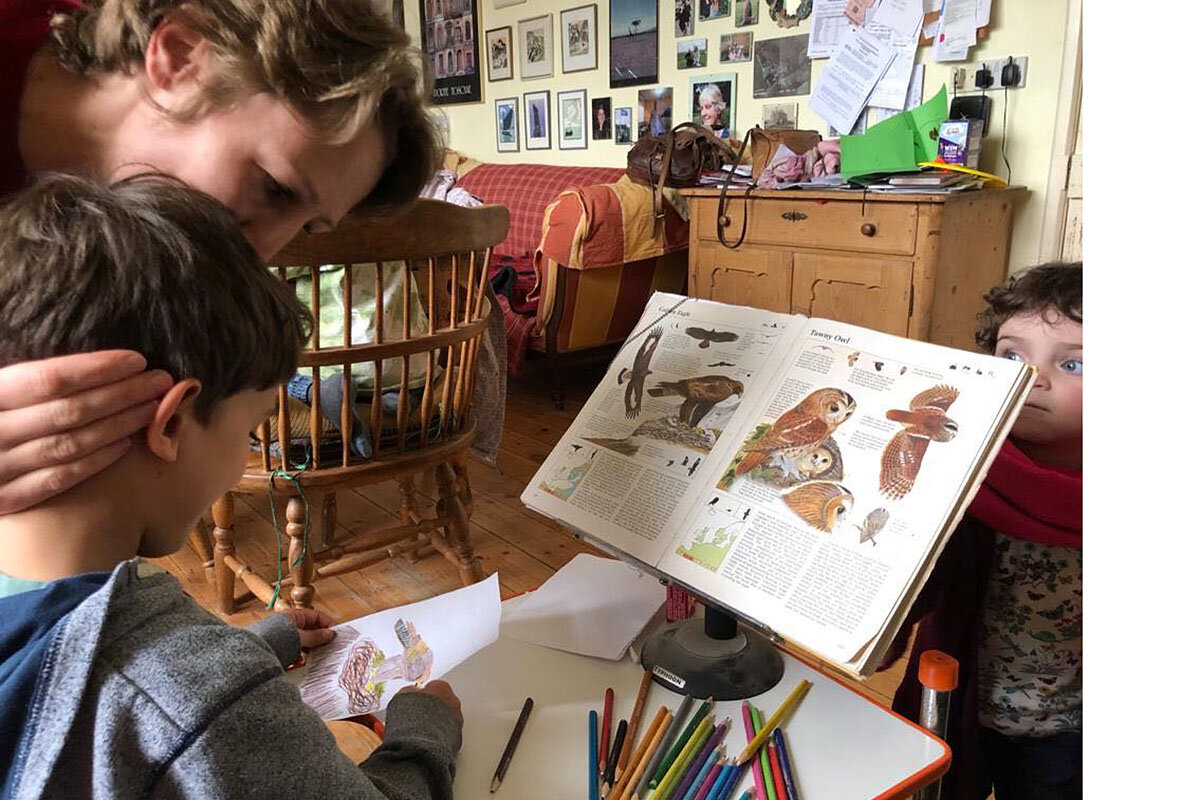Work and parent at the same time? A crisis highlights dual lives.
Loading...
| Mexico City; Acton, Mass.; and Basel, Switzerland
Three years ago, when the now viral video hit the internet of a father in a live television interview interrupted by two stumbling toddlers, professionals with kids around the globe laughed tears of schadenfreude.
But today, as schools and day cares are canceled, and governments worldwide encourage – or require – citizens to remain home to help slow the spread of the new coronavirus, the risk of their own client calls or video-conferences getting interrupted by crying kids or exasperated teens is exponentially high. So high, in fact, there are photos and videos posted online from late-night comedy hosts, university professors, local news anchors, and even Canadian Prime Minister Justin Trudeau (in self-quarantine) documenting the juggle of their “day jobs” with their now ever-evident roles as parents.
Editor’s note: As a public service, all our coronavirus coverage is free. No paywall.
Why We Wrote This
Many working parents feel pressure to hide the messy reality of balancing family and career. Now, as COVID-19 puts their dilemma in the spotlight, some see the seeds of long-term change.
Working from home while children are present is extremely challenging. For some families, it’s near impossible. Already the global lockdowns are testing fault lines around familial divisions of labor, employer expectations, gender stereotypes, and parental patience. But at this unique moment, it’s largely understood that if you have kids and are able to work remotely, the two worlds will collide. And that presents opportunities for employers and employees to rethink their perceptions about working parents, and possibly identify longer-term shifts that could benefit all.
Once we ease out of this crisis, “people are not going to want to work in the same way” they did before, says Deborah Croft, co-founder of Thriving Talent, a European company helping businesses and organizations meet their gender diversity goals. “People are going to be asking for different ways of working because they will have done it” and seen that it can work.
Bring on the chaos
Lauren Romansky from Acton, Massachusetts, regularly works remotely for a research and consulting firm based in Connecticut.
Now, with day care shuttered, Ms. Romansky and her husband trade off shifts of work and child care for their 2- and 4-year-old daughters, finishing up what remains after the kids are in bed. It makes for incredibly long days.
“What I’ve been trying to explain to a bunch of my colleagues who aren’t used to working remotely is this is not business as usual even just in terms of remote work,” says Ms. Romansky.
She thinks it’s too early to tell what impact the COVID-19 crisis will have on perceptions of working parents. But her daughters have been more visible to her colleagues than they normally are, which she embraces.
In part, that visibility is intentional. Her department started a daily optional exercise class that staff – and their families or roommates or pets – are invited to join.
It’s “a really great way to authorize everyone to recognize that we’re all working in different circumstances and it doesn’t have to be something we’re ashamed of or is a problem,” she says of the realities and responsibilities each person is juggling.
For Jamie Schroeder, a business operations manager for Google in Mountain View, California, kids showing up on team video calls has become something of a norm. “There’s lots of babies in the background that you hear, but it feels very empowering and [there’s] a supportive dynamic about it,” she says, adding that she doesn’t rush to mute her computer when her 16-month-old makes a peep.
“Most organizations are really trying to do something to make it easier” for parents now working from home with the added stresses of child care and schooling, says Ms. Croft. “It is teleworking where you are going to have children popping out and coming through the door. It’s going to be chaotic and there is an acceptance of the fact that that is the case.”
Some 56% of parents who also work professionally say it’s difficult to balance the responsibilities of work and family, according to a 2015 Pew Research Center survey. Parents often feel pressure to hide their “double lives” as caregivers from their employers, whether due to personal fears or long-established stigmas, experts say. Seventy-four percent of parents with kids under the age of 18 say they sometimes feel too busy to enjoy life, according to a 2018 Pew survey.
And that was all before most parents lost their child care amid the coronavirus crisis – child care that, even in “normal” times, is often excessively expensive. In every U.S. state, the cost of infant and toddler child care exceeds the federal definition of “affordable,” according to the Center for American Progress. On average, families in high-income countries around the world spend 14.5% of their income on child care, but those living in New Zealand, the United Kingdom, and the United States can expect to spend closer to one-third.
“The crisis has made this much clearer that these are universal problems that nearly all families are facing,” says Kathleen Gerson, a sociology professor at New York University who studies gender, work, and families.
“Now we can see how essential it is, both economically, and for personal well-being – and for family well-being – that we address the caregiving crisis in [our] society,” she says.
Not all bad?
Already, the disruptions in some parents’ lives are translating into hopes of more permanent shifts down the line.
“My view of working from home has changed a lot,” says Karla Martinez de Salas, editor in chief of Vogue Mexico and Latin America, who had never tried it before the pandemic.
In “normal” times, she is required to travel frequently for work, and returned from a trip to Italy in early March. That meant two weeks of self-quarantine, which she discovered was a “blessing in disguise” because of the time it allowed her to spend with her twin 4-year-old daughters.
“As [the girls] get older, it’s harder and harder to be away. So, perhaps working from [home] once or twice a week would be the ideal scenario for a mom like me,” she says.
With the COVID-19 crisis “we have accelerated that whole question mark of can we or can’t we do flexible working – because you have to,” says Ms. Croft from Thriving Talent.
Carlos Taboada, a human resources consultant in Monterrey, Mexico, and father of two, says he never liked the idea of his team members working remotely.
“I’m the worst at home office. I get distracted so easily,” he says. In the past, that perception translated to how he viewed it for his six direct reports, too – four of whom are parents.
Although Mexico hadn’t required business to close yet, Mr. Taboada gave his team the option to work from home starting in mid-March. He’s had to put a lot of faith into his employees to meet deadlines within the time frame they see fit for their particularly chaotic lives right now. Sometimes assignments are delivered at 1 a.m., but together they’re making it work.
“I’ve seen baseballs thrown in the background of calls, a cleaning woman dancing with her mop, a client breastfeeding,” he says of the past two weeks of work calls. His takeaway is that in the future, it’s going to be even more important to balance these personal, family needs with the needs of business.
But the flexibility to work from home is not a win for everyone.
“It’s been enormously disruptive,” says Julia Rous, a self-employed single mother in the British village of Horsley, who juggles three jobs including teaching. The loss of steady income combined with schools’ shift to distance learning is taking its toll. “There is no support in self-employment.”
Moms bear the brunt
Gender fault lines in juggling home and work are not new, but are shining brighter than ever in recent weeks. According to a recent Kaiser Family Foundation survey, both fathers and mothers are fretting more about the effects of coronavirus on their well-being and earnings than people without children. However, women report being more worried: 36% say the stress has had an impact on their mental health, versus 27% of men.
“Changes always are slower than we’d hope. But there are so many men disconnected from the sphere of the home and caregiving and this moment obligates them to confront it,” says Nicko Nogués, founder of the Instituto de Machos a Hombres. The organization tries to challenge machismo across Latin America and parts of Europe via partnerships with private companies and international organizations.
“It opens an opportunity where we can show men that they have a lot to gain getting more involved at home,” he says.
There’s more acceptance among working parents that they’re doing their best – even if the hodgepodge nature of caring for kids and meeting deadlines is best encapsulated in internet memes these days.
“I think the ‘aha’ moment is coming and in an even bigger way, but I don’t think it’s come just yet,” says Daisy Wademan Dowling, founder and CEO of the consulting firm Workparent, which trains companies how to support and retain parents.
“Most people are naturally in shock and in scrambling mode, and thinking about some of the bigger implications has fallen by the wayside compared to just figuring out how to get your job done, how to keep your kids safe, how to go about daily life,” she says.
Editor’s note: As a public service, all our coronavirus coverage is free. No paywall.






